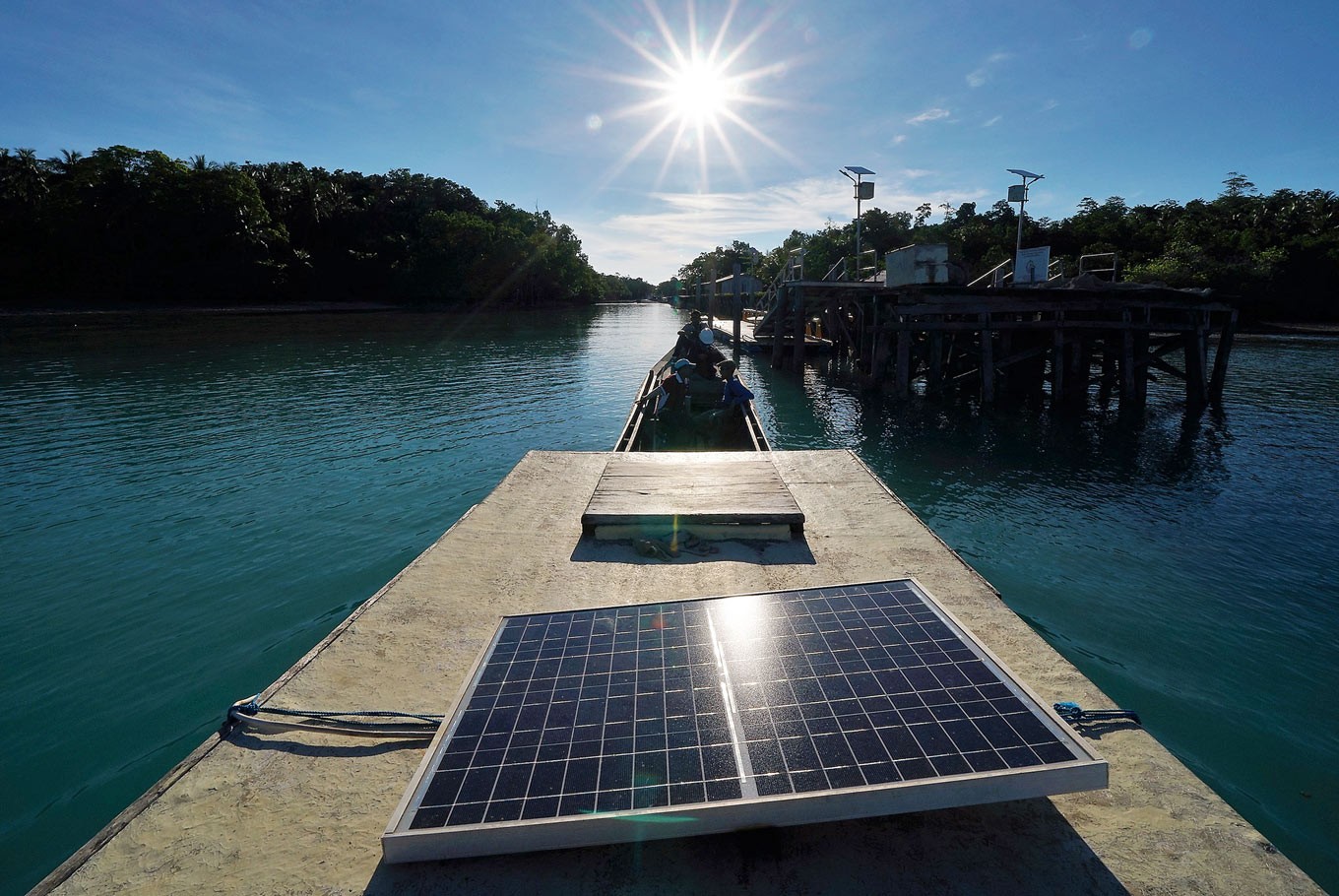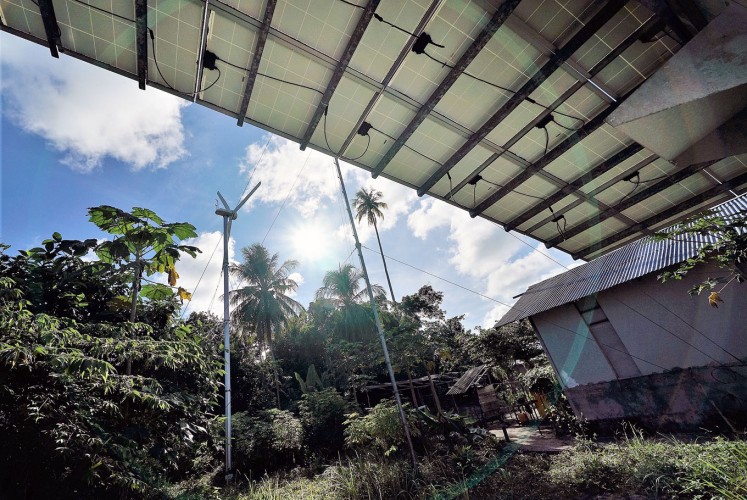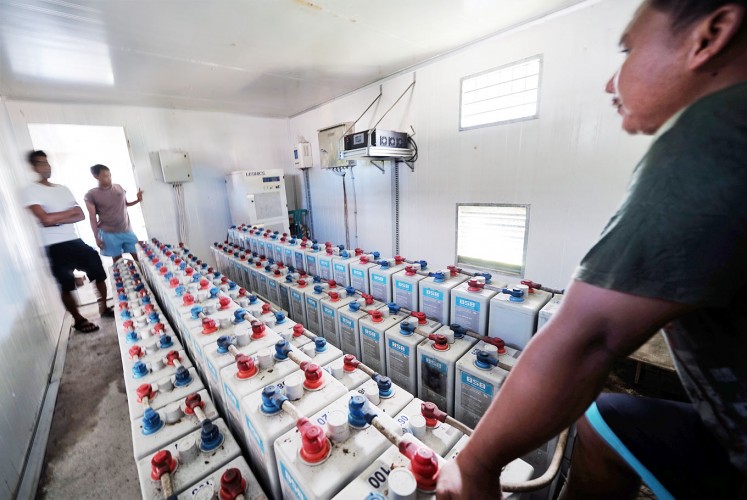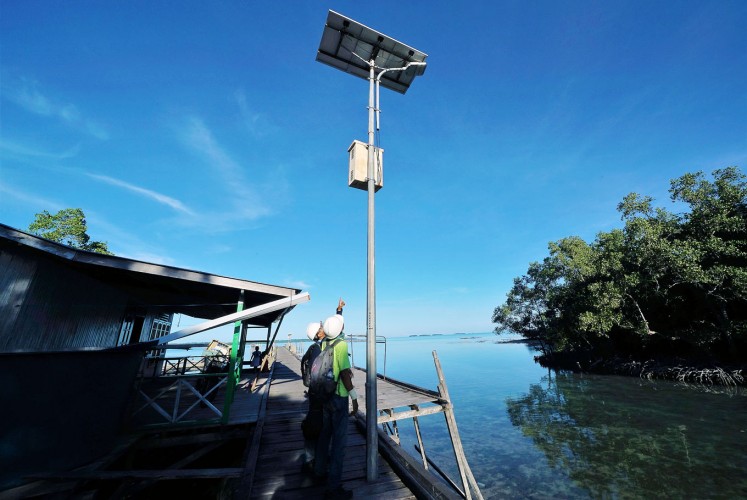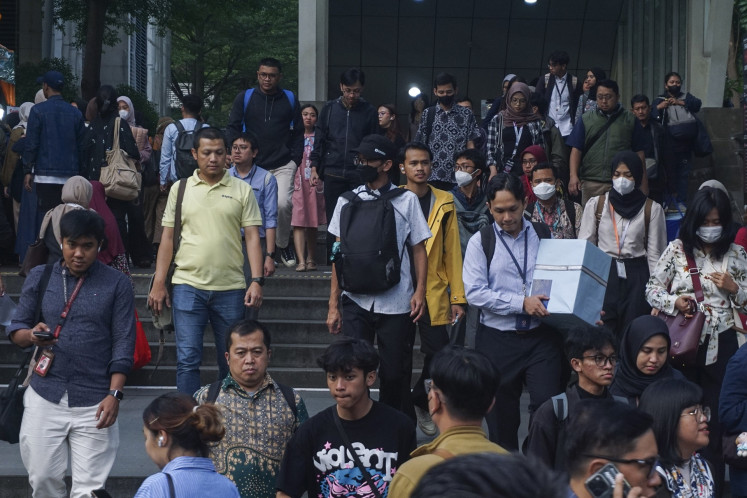Popular Reads
Top Results
Can't find what you're looking for?
View all search resultsPopular Reads
Top Results
Can't find what you're looking for?
View all search resultsMaratua's solar power to cut carbon emissions
Solar energy brings hope to residents in the remote area of Maratua, East Kalimantan.
Change text size
Gift Premium Articles
to Anyone
T
he heat of the sun was seemingly boiling the waters of Maratua Island in Berau regency, East Kalimantan, as the single-engine boat owned by Lasahi, 52, was passing Alulu Bay making it necessary to cool the engine so as not to stall at sea.
Unlike in the past, however, Lasahi had no need to pump sea water into the boat’s cooling device. For almost two years now, the pumping work has been replaced by a solar power cooling system that is connected with a solar panel through a battery to transmit its energy by means of simple electric cables.
“I use a wet-cell battery,” said Lasahi, who cannot afford a dry-cell battery because it’s expensive even though it’s recommended for solar power. Nonetheless, he can manage to transport 50 to 150 sacks of sand daily to be sold to contractors undertaking building construction in several parts of Maratua Island.
With a land zone of only 384.36 square kilometers and a water area of 3,735.18 square km, the island is shaped like a curved blade, bending from the south to the north and pointing at the southeast. Shallow waters stretch from the middle to the upstream area, which turns into an expanse of sand when the tide is ebbing.
Sea transportation by boat is widespread, carrying passengers and goods from one bay to another on Maratua. Land transportation is limited due to the absence of inter-village ring roads and unless the government expedites the construction of land routes, the island will continue to depend on waterways.
“Sea conveyance is costlier and often hampered by weather,” Lasahi said.
Yet sea trips are certainly Lasahi’s personal choice. As long as his boat keeps operating to transport sand and passengers along the coves on the island, he will always rely on the solar panel installed atop the boat’s roof, which he received from the Ministry of Energy and Mineral Resources.
Dynamic duo: Residents on Maratua use the combination of solar energy and a windmill to generate electricity. (JP/Syafrizaldi)Meanwhile, an Alulu Bay villager, Ayu Siti Wahyuni, 22, said that like the 135 other families in the village, she was allocated 800 watts of electricity daily, derived from a solar power generator located at the tip of the settlement nearly 3 km away from her home.
The solar power generator (PLTS) of Alulu Bay has a capacity of 44 kilowatts-peak (kWp), with around 120 solar panels capturing, storing and converting energy to meet the locals’ electricity demands.
Ayu uses the power supply only for illumination, as it’s impossible to use a washing machine and refrigerator.
“For watching TV, it just lasts one to two hours,” she said, adding that her family prioritized the use of electricity for her sixth-grade niece, who needed it to study in the evening.
A native of Alulu Bay, Maidah, 60, now feels happy to see her grandchildren getting lights to study in the evening. Previously, the family used torches made from dried coconut leaves for outdoor lighting. They used oil lamps made of used bottles or cans for indoor lighting.
Kirno, a fisherman and Ayu’s husband, has to store his catch in fiber boxes filled with ice blocks to keep the fish fresh.
“This is even more required if the fish has to be sold in Tanjung Redeb [Berau’s capital]. It can take 12 hours to sail from Maratua to Tanjung Redeb,” he said.
Therefore, Kirno is now actively involved in the building of an ice factory located right next to his home and covering an area of almost half a hectare. The plant uses a PLTS to absorb solar energy.
“The fund for the construction comes from the Millennium Challenge Account-Indonesia [MCA-Indonesia] program, committed to develop environmentally friendly businesses. We’re fortunate to be part of this effort,” said Kirno.
Inside the facility: Operators of the PLTS (solar power generator) Teluk Harapan explain how the facility works. (JP/Syafrizaldi)The factory’s 54-kWp PLTS will be able to operate ice-making machines with a daily capacity of two tons. The local community is directly participating in planning, training, factory development and product management. The ice factory would be use to support fishermen, so they would be able to reduce their ice block purchase expenditures.
Kirno and his fellow villagers are handling the factory development through the facilitation of the Indonesian Bio-Diversity Foundation (KEHATI) as the fund management agency and the Java Learning Center (JAVLEC) as a partner of MCA-Indonesia.
Still, Kirno has to learn from PLTS failures in various places on Maratua.
In Teluk Harapan village, for example, residents regretted the improperly managed PLTS construction.
“Road lamps only lasted for two months and they’ve been off for two years,” Nursiah said. The road lights, she added, were built along with the village’s PLTS development, but right now generator was no longer operating, making local people rely again on costly diesel power.
Former Teluk Harapan PLTS operator Dadang Wahyudi acknowledged the far cheaper solar power. Each of the 100 village homes supplied by the PLTS only pays Rp 30,000 a month. Technically, according to him, PLTS durability is determined by the maintenance of equipment like batteries and the repair or replacement of worn-out batteries.
He has reported the battery damage to the village administration, but new batteries are too expensive to purchase. Dadang confirmed Kirno’s view of the importance of direct community involvement. The key to continuity lies with the community, which should understand how to manage and should have common awareness.
“The PLTS is a community asset that should be maintained together. If this happens it will keep operating,” he said.
Green energy: Two workers check a street lamp that uses solar power on Teluk Harapan. (JP/Syafrizaldi)Dadang disclosed that Maratua villages had owned PLTS units, but many had ceased operation after two to three years because of operational and repair cost shortages as well as the lack of community awareness.
“The same applies to the Alulu Bay ice factory. Without the participation of Pak Kirno and villagers there, I’m afraid the plant won’t work,” he said.
Asep Suntana, the director of the community-based natural resources management program of KEHATI, said Kirno’s effort should be appreciated. This will facilitate Maratua fishermen’s operations and set an example for their peers in remote regions. The same is true of Lasahi’s transportation business and other similar initiatives.
“PLTS projects constitute a joint commitment to lower carbon emissions and at the same time promote people’s economy,” he said. In Asep’s observation, the earth’s temperature will increase unless people make prompt adaptation and mitigation. Such efforts should conform to the use of renewable energy like solar energy.
Although remote from the State Electricity Company (PLN), Maratua won’t keep silent. The island’s renewable energy development will keep going.
“This will contribute to Indonesia’s carbon emission cut in 2020,” Asep said.

